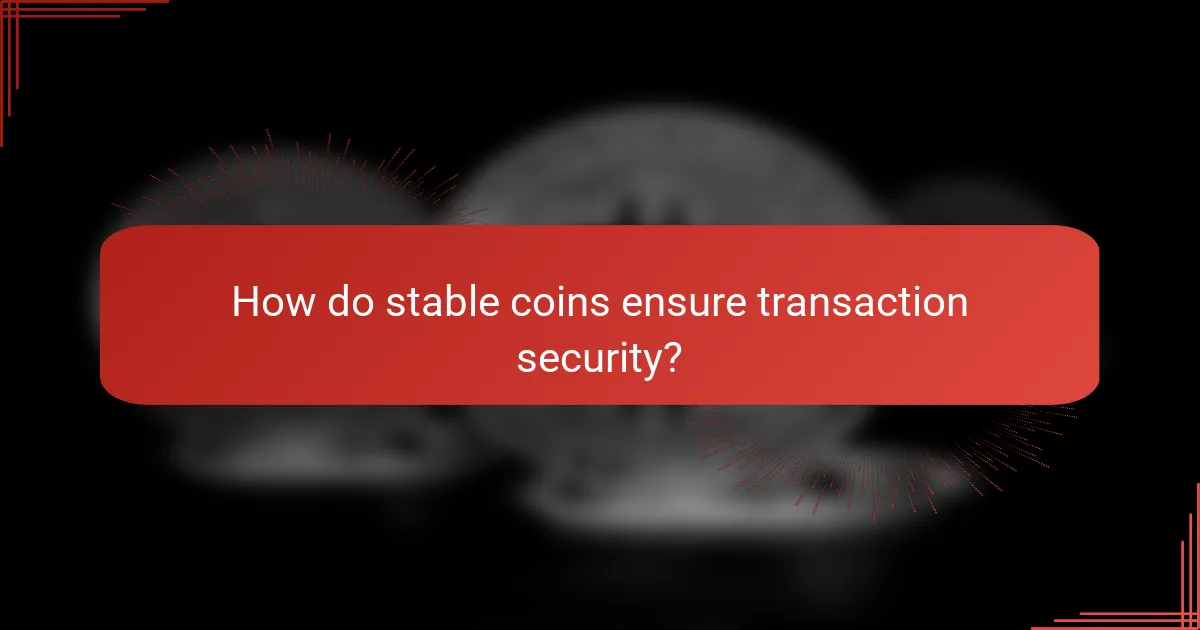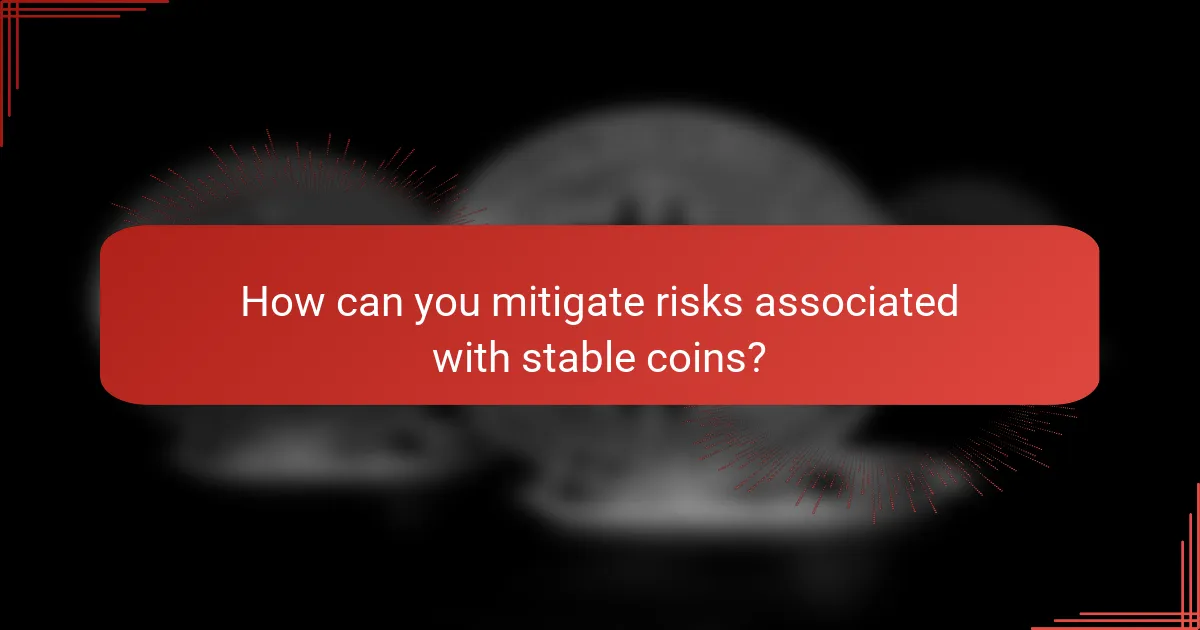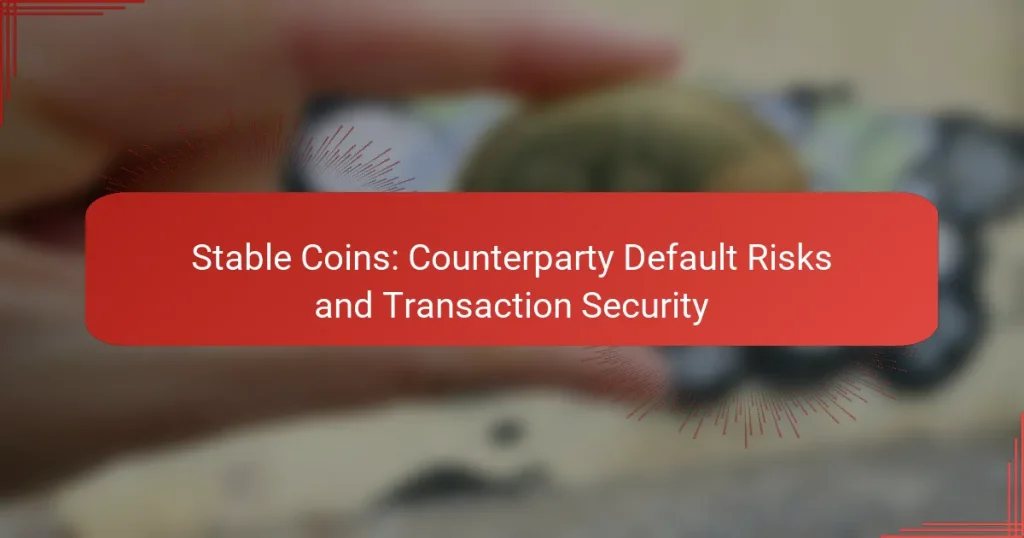Stable coins play a crucial role in the cryptocurrency ecosystem by providing a stable value pegged to traditional currencies, such as the US dollar. However, they carry counterparty default risks, which can arise from issuer insolvency or market fluctuations, potentially impacting their value for holders. To ensure transaction security, stable coins employ advanced technologies like blockchain, regular audits, and multi-signature wallets, creating a safer environment for users.

What are the counterparty default risks of stable coins?
Counterparty default risks of stable coins arise when the issuer of the stable coin fails to meet its financial obligations, potentially leading to a loss of value for holders. These risks can stem from various factors, including issuer insolvency, regulatory changes, and market volatility.
Risk of issuer insolvency
The risk of issuer insolvency is a significant concern for stable coin holders. If the entity backing the stable coin becomes insolvent, it may not be able to redeem the coins for their intended value. This situation can lead to a loss of confidence and a sharp decline in the stable coin’s market price.
To mitigate this risk, investors should research the financial health and transparency of the issuer. Look for stable coins backed by reputable companies with solid reserves and regular audits to ensure that they can fulfill redemption requests.
Impact of regulatory changes
Regulatory changes can greatly affect the stability and usability of stable coins. Governments may impose new regulations that restrict the issuance or trading of certain stable coins, impacting their liquidity and value. For instance, stricter compliance requirements could lead to increased operational costs for issuers.
Investors should stay informed about the regulatory landscape in their jurisdiction. Monitoring developments in cryptocurrency regulations can help anticipate potential risks and make informed decisions regarding stable coin investments.
Market volatility effects
Market volatility can also pose risks to stable coins, particularly those pegged to fiat currencies. While stable coins aim to maintain a fixed value, extreme market conditions can lead to temporary dislocations, causing the stable coin to trade below or above its intended peg.
To navigate this risk, investors should consider diversifying their holdings and using stable coins that have mechanisms in place to stabilize their value during turbulent market periods. Understanding the underlying assets and their correlation with market movements can provide additional insights into potential risks.

How do stable coins ensure transaction security?
Stable coins ensure transaction security through a combination of advanced technologies and practices designed to minimize risks. Key methods include the use of blockchain technology, regular smart contract audits, and multi-signature wallets, all of which contribute to a secure transaction environment.
Use of blockchain technology
Blockchain technology underpins stable coins by providing a decentralized and immutable ledger for transactions. This transparency allows users to verify transactions independently, reducing the risk of fraud. Additionally, the distributed nature of blockchain enhances security, as altering any transaction would require consensus across the entire network.
Many stable coins operate on established blockchains like Ethereum or Binance Smart Chain, which are known for their robust security features. Users should ensure they are using stable coins that leverage reputable blockchains to benefit from these security advantages.
Smart contract audits
Smart contracts are self-executing contracts with the terms directly written into code. Regular audits of these contracts are crucial for identifying vulnerabilities that could be exploited. Reputable stable coin projects often undergo third-party audits to ensure their smart contracts are secure and function as intended.
Investors should look for stable coins that provide audit reports from recognized firms. This practice not only enhances trust but also signals a commitment to maintaining high security standards.
Multi-signature wallets
Multi-signature wallets require multiple private keys to authorize a transaction, adding an extra layer of security. This means that even if one key is compromised, unauthorized transactions cannot occur without the additional keys. Many stable coin projects utilize multi-signature wallets to safeguard their funds and ensure that transactions are executed only with consensus from multiple parties.
When selecting a stable coin, consider whether it uses multi-signature wallets as part of its security protocols. This feature can significantly reduce the risk of theft and enhance overall transaction security.

What are the best stable coins for security in the US?
The best stable coins for security in the US include USDC, DAI, and TrueUSD. These coins are designed to maintain a stable value by being pegged to the US dollar, providing a reliable option for transactions while minimizing counterparty default risks.
USDC (USD Coin)
USDC is a fully-backed stable coin issued by regulated financial institutions. Each USDC is pegged to one US dollar, ensuring that it retains its value and can be redeemed for USD at any time.
USDC is known for its transparency, as it undergoes regular audits to verify that the reserves match the circulating supply. This makes it a trusted choice for users concerned about security and counterparty risks.
DAI (Dai Stablecoin)
DAI is a decentralized stable coin that is not directly backed by USD but is collateralized by other cryptocurrencies. Users can lock up assets in a smart contract to generate DAI, which maintains its peg to the US dollar through a system of incentives and penalties.
While DAI offers a level of decentralization that appeals to many users, it also introduces risks associated with the volatility of the collateral assets. Users should be aware of these risks when considering DAI for secure transactions.
TrueUSD
TrueUSD is a fiat-backed stable coin that aims to provide transparency and security through regular attestations of its reserves. Each TrueUSD is redeemable for one US dollar, similar to USDC.
TrueUSD stands out for its commitment to regulatory compliance and its use of third-party escrow accounts to hold the reserves. This approach helps mitigate counterparty risks, making it a reliable option for users seeking stability in their transactions.

What criteria should you consider when choosing a stable coin?
When selecting a stable coin, focus on regulatory compliance, the transparency of backing assets, and liquidity. These factors significantly impact the coin’s reliability and security in transactions.
Regulatory compliance
Regulatory compliance is crucial when choosing a stable coin, as it ensures that the coin adheres to local laws and regulations. Coins that comply with regulations are less likely to face legal challenges, which can affect their stability and usability.
Check if the stable coin is registered with relevant authorities in your jurisdiction, such as the Financial Crimes Enforcement Network (FinCEN) in the U.S. or the European Securities and Markets Authority (ESMA) in the EU. Compliance can enhance trust and reduce counterparty risks.
Backing assets transparency
The transparency of backing assets is vital for assessing the stability of a stable coin. A reliable stable coin should clearly disclose the assets it is pegged to, such as fiat currencies or commodities, and provide regular audits to verify these holdings.
Look for stable coins that publish their reserves and undergo independent audits. This practice helps ensure that the coin is genuinely backed by sufficient assets, reducing the risk of default and enhancing user confidence.
Liquidity and market cap
Liquidity and market capitalization are important indicators of a stable coin’s reliability. A higher market cap typically suggests greater trust and stability, while good liquidity ensures that you can easily buy or sell the coin without significant price fluctuations.
When evaluating liquidity, consider the trading volume on major exchanges. A stable coin with a daily trading volume in the millions is generally more liquid, allowing for smoother transactions and lower slippage. Aim for coins with a market cap in the hundreds of millions to billions for better stability.

How can you mitigate risks associated with stable coins?
Mitigating risks associated with stable coins involves implementing strategies that enhance security and reduce exposure to counterparty defaults. Key approaches include diversification, regular audits, and utilizing insurance products to safeguard investments.
Diversification strategies
Diversification is a crucial strategy for reducing risk in stable coin investments. By spreading investments across multiple stable coins or even different asset classes, you can minimize the impact of a single point of failure. For instance, consider allocating funds among USD-backed, EUR-backed, and crypto-collateralized stable coins.
Additionally, diversifying your portfolio geographically can help mitigate risks tied to specific regulatory environments. Investing in stable coins from different jurisdictions can provide a buffer against localized market fluctuations or regulatory changes.
Regular audits and updates
Conducting regular audits of the stable coin issuer’s reserves is essential for ensuring transparency and trustworthiness. Look for stable coins that undergo third-party audits, which verify that the issuer holds sufficient assets to back the circulating tokens. This practice can significantly reduce counterparty risk.
Staying informed about updates and changes in the stable coin’s operational framework is equally important. Subscribe to the issuer’s communications and follow industry news to ensure you are aware of any potential risks or changes that could affect the stability of your investment.
Using insurance products
Insurance products can provide an additional layer of protection against counterparty defaults in the stable coin market. Some platforms offer insurance coverage for digital assets, which can help mitigate losses in case of a security breach or insolvency of the issuer.
When considering insurance options, evaluate the terms and coverage limits carefully. Ensure that the insurance provider is reputable and that the policy covers the specific risks associated with the stable coins you hold. This proactive approach can enhance your overall security strategy.


